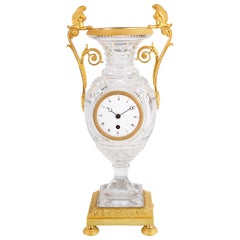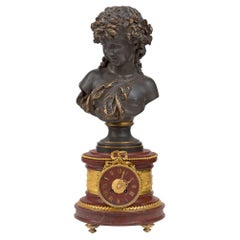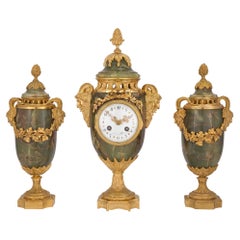Ormolu Clocks
Late 19th Century French Louis XVI Antique Ormolu Clocks
Ormolu
19th Century French Louis XVI Antique Ormolu Clocks
Marble, Bronze, Ormolu
19th Century French Louis XVI Antique Ormolu Clocks
Onyx, Ormolu
19th Century French Napoleon III Antique Ormolu Clocks
Bronze, Ormolu
Antique Ormolu Clocks for Sale on 1stDibs
Antique ormolu clocks and other decorative objects can be incorporated into a variety of spaces, and while demand for the material and/or technique was at its peak in Europe during the 18th and 19th centuries — older French ormolu clocks are especially coveted today — ormolu is still widely loved by contemporary designers and collectors.
What is ormolu?
Ormolu is a brilliant form of decorative trickery. To the untrained eye, ormolu clocks, jewelry boxes and other ormolu furniture and decor look like they're made of solid gold. But those in the know recognize ormolu — or elaborate bronze gilding — as having been essential to French design in the 18th and 19th centuries as a cornerstone of the neoclassical and Empire styles.
“Most commonly, ormolu refers to a bronze object that has been covered with gold, typically 18 karat or 24 karat,” explains Jamie Sinai, director of the antiques specialist Mayfair Gallery, in London. “For that reason, ormolu is sometimes called gilt bronze or, in French, bronze doré. Strictly speaking, however, the term ormolu also denotes the technique of applying gold to a metal.”
“The word comes from the French or moulu, which translates as ‘ground or powdered gold’ — the form the gold takes before it is applied to a metal surface.”
From the court of King Louis XVI to that of Napoleon I, the French elite snapped up furniture mounted with ormolu, as well as sconces, candelabra and table lamps made from the material.
If you're looking to bring a touch of this 19th-century pizzazz to your desk, an antique ormolu desk clock is a decorative touch that blends ornament and functionality. The clamor for desk clocks arose as the Industrial Revolution transitioned labor from outdoors to indoors, and allowed for the mass production of clock parts in factories. Naturally, elaborate designs soon followed and clocks could be found made by artisans and luxury houses like Cartier. Indeed, an ormolu clock is an object to be admired in your home as much as it is a necessary functional element. (This is part of the reason clocks make such superb collectibles!)
Today, antiques collectors and interior designers seek out the finest in antique ormolu clocks and continue to prize ormolu for its extraordinary craftsmanship and history-infused glamour.
“This wondrous material was highly sought after in France as the ultimate luxury. It magically resembled solid gold and sparkled under candlelight,” says Sinai.
Find antique ormolu desk clocks, wall clocks, mantel clocks and other furniture and decorative objects on 1stDibs.



